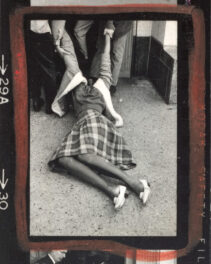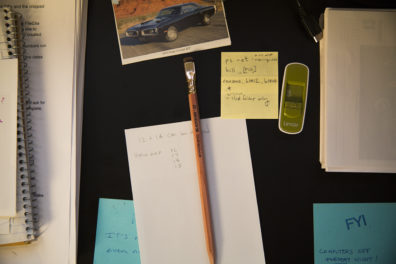
Detail from “How to Tell Your Friends from the Japs,” Time magazine, December 22, 1941 (Vol. XXXVIII, No. 25), p. 33. Digital image: Tristan Bravinder
Art historian Linda Kim pursued research using the Malvina Hoffman Papers at the Getty Research Institute, a nearly complete archive documenting Hoffman’s life and career as a sculptor and writer. Kim’s book, Race Experts: Sculpture, Anthropology, and the American Public in Malvina Hoffman’s Races of Mankind, will be published this spring by the University of Nebraska Press. Here the author reflects on an important discovery she made within the archive. —Ed.
Confronted with 216 boxes (approximately 150 linear feet) of archival material, I soon realized that theory must precede practice. The Malvina Hoffman papers has just too much data–journals, sketchbooks, letters, scrapbooks, photograph albums, invoices, and receipts–to absorb without some preliminary ideas to organize one’s findings. Hoffman (1887–1966) was an inveterate packrat of anything that could contribute to her artistic legacy, assembling a meticulous record of her almost six decades as a sculptor. This habit was a consequence, I believe, of her time spent with Auguste Rodin, another artist who, despite an active professional life, kept a steady gaze on posterity.
My objective was to reconstruct the conditions of a single project, the Races of Mankind, the 104 life-size bronze sculptures Hoffman made in the early 1930s for the Field Museum of Natural History in Chicago. I sought to find out why Hoffman, a fine-arts-trained sculptor with no background in anthropology or museum exhibits, was commissioned by Chicago’s natural history museum to make the largest race exhibit ever installed in a museum and also one of the largest sculptural commissions ever undertaken by a single artist. I decided, therefore, to focus on those materials among her papers that would yield the most insights on the Races of Mankind—her correspondence with the museum staff, anthropologists and fieldworkers, and the notes and sketches as well as photographs of her subjects. But there was constant temptation to stray from my singular purpose because Hoffman had a wide network of correspondents that included such early-twentieth-century celebrities as Anna Pavlova, Pearl S. Buck, Ignace Paderewski, Uday Shankar, and Mabel Dodge Luhan.
Eventually, I discovered some of my most important insights about the Races of Mankind not in the official records of the commission but in the exchanges between Hoffman and ordinary Americans. I realized that the museum’s recruitment of Hoffman was premised, not on her ability to engage anthropologists and scientists in their new exhibit on race, but, as one contemporary noted, “to interest the public in the study of mankind.”(1). I began to see my project as situating the Races of Mankind within popular conceptions of race, and Hoffman as an artist who mediated between science and the public. In the letters from everyday people who wrote to Hoffman about the Races of Mankind, I saw glimpses into how the popular imaginary of race functioned in the reception of her sculptures. Along the way, I found that race had a way of distorting how average Americans saw the subjects of the sculptures, blunting or misdirecting vision, and submerging differences while exaggerating others.
I came across one such example among the miscellaneous items in a folder marked “Correspondence, L: General and Friends.” There, in a letter from a young man in California, I noticed a remarkable case of misrecognition, in which the man perceived race without perceiving the individual. The writer, Carroll Lorbeer, wrote to Hoffman after reading a Time article about the artist and her Races of Mankind work that appeared on January 9, 1933.
I read with great interest the account of your work and recent experiences with Dr. Hu Shih. But your head of Dr. Hu has intrigued me. Having enjoyed several conferences with Dr. Hu while in China, I have become a great admirer of him and his work. I wish to know if any reproductions, smaller than the one shown in Time’s cut, either full-length or of the head, can be had?
Lorbeer was referring to a photograph that appeared alongside the article, that showed Hoffman seated next to a monumental carved stone head, holding a smaller sculpture in her hand. Underneath the photograph, the caption read, “Malvina Hoffman (& Head of Shih) / She worked while Shanghai was being sacked.”

Photograph published in “Head Huntress,” Time magazine, January 9, 1933 (Vol. XXI, No. 2), p. 33. Digital image: Tristan Bravinder, from the collection of the Santa Monica Public Library
In the same folder containing Lorbeer’s inquiry, however, there is a copy of a rather salty communication from Hoffman’s secretary to Henry Luce, the publisher of Time, regarding this very photograph. Hoffman’s secretary informed Luce that the magazine had mistakenly identified the sculpture in the photograph, for the carved stone head was neither the reputed portrait of Dr. Hu nor a work by Hoffman at all, but instead, “an ancient Chinese head.”
The actual sculpture by Hoffman for which Dr. Hu modeled was a bronze bust entitled Chinese Type of Scholar, Central China, a part of the Races of Mankind series. Comparing this work to that of the “ancient Chinese head” in the Time photograph, one can understand why Hoffman felt it necessary to correct the record. The differences between the two works are quite striking. In Hoffman’s bust, Dr. Hu is represented as a young man, in spite of all his professional accomplishments (he was a Cornell and Columbia-trained professor of philosophy at Peking National University). His skin is smooth and unwrinkled, yet the small rolls of flesh beneath his eyes and the crescent-shaped hollows above his cheeks give him a slightly careworn appearance. In contrast to these particularized marks of the bust, the carved stone head in the photograph presents the placid smile, heavy-lidded eyes, and pendulous ears generic to so many sculptural buddhas and Eastern sages.

Chinese Type of Scholar, Central China, from the Races of Mankind, 1930–34, Malvina Hoffman. Photograph from the Malvina Hoffman papers, The Getty Research Institute, 850042. © The Field Museum
Yet, despite the great disparities in the two faces–bronze bust and stone head–Lorbeer, who was personally acquainted with Hu, seems not to have registered this misidentification in any way. He was so convinced that the “ancient Chinese head” was a likeness of Hu that he wanted to purchase a small-scale reproduction of it. It’s hard to say why Lorbeer was unable to recognize this mix-up, but it may have been the stone head’s very abstraction, its generic marks of “oriental” wisdom, that beguiled Lorbeer, transmuting his memory of Hu’s physical particularity into a formulaic representation of Asian-ness.
A few months after Hoffman received the letter from Lorbeer, an article appeared in the Chicago Tribune that described a public lecture in which Hoffman showed slides of the Races of Mankind sculptures. The reporter noted a curious phenomenon in which members of the audience sometimes misidentified the subjects represented in the bronzes. “For instance, when a front and a side view of a Mongolian was thrown on the screen there was applause from Mussolini’s admirers, for the picture looked so much like the Italian dictator.”(2) This conflation of Hoffman’s bust of a Mongolian with that of Benito Mussolini–someone whose features were regularly recorded in the press and should have been familiar to his “admirers”–presents another instance, alongside that of Lorbeer and Hu, of the difficult and elusive task of identifying racial subjects in Hoffman’s sculptures.

Mongol Man from the Races of Mankind, 1930–34, Malvina Hoffman. © The Field Museum, Catalog No. 337106, photographer Shelley Smith
These cases of misrecognition go to the heart of my research on the Races of Mankind, which explores the frequent lapses in racial discernment among Hoffman’s audience and how, when it came to race in the 1930s, everyday people just got it wrong. Despite Hoffman’s avowed role in the Races of Mankind project, to present everyday Americans with striking, concrete representations of different races, my study demonstrates that viewers of the multitude of bronze faces and figures in the Chicago exhibit often mis-perceived or mis-construed its anthropological lessons.
The endurance of these errors in racial judgment can be reckoned by the appearance of another article in Time, almost ten years after the botched caption of the Hoffman photograph. Shortly after the bombing of Pearl Harbor and in the wake of numerous attacks on Chinese as well as Japanese Americans, Time magazine published a photo-illustrated guide entitled, “How to Tell Your Friends from the Japs.”(3) Instead of condemning racial violence and discrimination committed against anyone–Japanese or otherwise–Time proposed to help its readers become more discerning bigots, setting forth a checklist of features–mostly physical but some behavioral–that distinguished the Japanese from the Chinese. The article begins with the qualification that “there is no infallible way of telling them apart” and “even an anthropologist, with calipers and plenty of time to measure heads, noses, shoulders, [and] hips, is sometimes stumped,” but then confidently goes on to parse out body builds and heights, facial hair, and eye shapes.

“How to Tell Your Friends from the Japs” in Time magazine, December 22, 1941 (Vol. XXXVIII, No. 25), p. 33. Photo: Tristan Bravinder, from the collection of the Santa Monica Public Library
This stubborn resistance to relinquish knowledge claims on race, despite overwhelming evidence of human fallibility in identifying members of other races, persists today. Even after witnessing the catastrophes created by racial certainty in World War II, when it comes to race, we still cling to our sense that we know one when we see one. Perhaps these episodes from the past in which people’s racial discernment was clearly overestimated might compel some humility and self-reflection on our command of race and how it is we remain so certain of it.
Notes
1. Arthur Keith, “Races of the World: A Gallery in Bronze,” New York Times (May 21, 1933), Sunday magazine, 10.
2. Judith Cass, “Miss Hoffman Tells Hunt for World Types. Sculptor Shows Pictures Made on Tour,” Chicago Daily Tribune (April 4, 1933), 17.
3. “How to Tell your Friends from the Japs,” Time 38, no. 25 (December 1941), p. 33. Life published a lengthier, more lavishly illustrated version, “How to Tell Japs from the Chinese,” on the same day (December 22, 1941), 81–82.




Thank you for sharing information about Malvina Hoffman. You may know about the illustrated chapter in the 1963 edition of the Hammond’s World Atlas Classics Edition with several photos of her “Races of Mankind” sculptures. I particularly like the chapter’s preface: For many years the word “race” was freely and uncritically used by anthropologists, it has even been made to include psychological ad social qualities, and has often been confused with nationality, also, it has been allied with ideas of inherent superiority or inferiority. Let it be clear that by “race” we mean a certain combination of heritable physical traits, without any implication of social status or psychological attributes.
As biographer for Malvina Hoffman I am at a loss why the artist, commissioned to show the humanity of the people around the world, in bronze is subjegated to a distorted reputation which has nothing to do with her thoughts about mankind and humanity. The artist not only was one of the finest sculptors of the 20th century but a humanitarian. The commission was almost impossible yet she completed it on time, on budget and beautifully. She saw no difference between people, no matter their race or religion. She believed we all came from the same source. We are all one. Hoffman sought to show the truth in her art, and the truth was the humanity of the individuals she sculpted. My book Beautiful Bodies, The Adventures of Malvina Hoffman will be available in a few weeks. It proves once and for all, this artist always came from a place of equality and love of her fellow man. She was NOT the science of the exhibition. She was a commissioned artist who did as she was hired to do